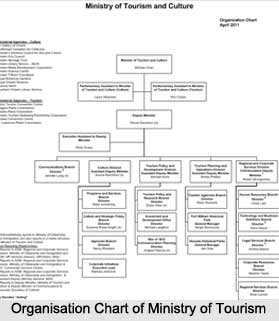 The Ministry of Tourism is the nodal agency for the formulation of national policies and programmes and for the co-ordination of activities of various Central Government Agencies, State Governments and the Private Sector for the development and promotion of tourism in the country. This Ministry is headed by the Union Minister for Tourism and supported by Minister of State for Tourism.
The Ministry of Tourism is the nodal agency for the formulation of national policies and programmes and for the co-ordination of activities of various Central Government Agencies, State Governments and the Private Sector for the development and promotion of tourism in the country. This Ministry is headed by the Union Minister for Tourism and supported by Minister of State for Tourism.
Organisation of Ministry of Tourism
The administrative head of the Ministry is the Secretary (Tourism). The Secretary also acts as the Director General (DG) Tourism. The office of the Director General of Tourism, now merged with the office of Secretary (Tourism), provides executive directions for the implementation of various policies and programmes. Directorate General of Tourism has a field formation of 20 offices within the country and 14 offices abroad and one sub-ordinate office/project i.e. Indian Institute of Skiing and Mountaineering (IISM)/ Gulmarg Winter Sports Project. The overseas offices are primarily responsible for tourism promotion and marketing in their respective areas and the field offices in India are responsible for providing information service to tourists and to monitor the progress of field projects. The activities of IISM/GWSP have now been revived and various Ski and other courses are being conducted in the Jammu & Kashmir Valley.
The Ministry of Tourism has under its charge a public sector undertaking, the India Tourism Development Corporation and the following autonomous institutions: Indian Institute of Tourism and Travel Management (IITTM) and National Institute of Water Sports (NIWS); National Council for Hotel Management and Catering Technology (NCHMCT) and the Institutes of Hotel Management.
Functions of Ministry of Tourism
The Ministry of Tourism functions as the prime agency for the development of tourism in the country. It plays a crucial role in coordinating and supplementing the efforts of the State/Union Territory Governments, catalyzing private investment, strengthening promotional and marketing efforts and in providing trained manpower resources. The functions of the Ministry in this regard mainly consist of the following: all policy matters, including development policies, incentives, external assistance, manpower development, promotion and marketing, investment facilitation. It is also responsible for planning, co ordination with other Ministries, Departments, State/Union Territory Governments, regulation of standards and guidelines, infrastructure and product development, central assistance, human resource development, publicity and strategies, research, analysis, monitoring and evaluation, international co-operation and external assistance, legislation and parliamentary work, establishment matters, vigilance matters, implementation of official language policy, budget co-ordination and related matters, plan-coordination and monitoring.
The Functions of Attached Office viz. Directorate General of Tourism are- assistance in the formulation of policies by providing feedback from the field offices; monitoring of Plan Projects and assisting in the plan formulation, coordinating the activities of field offices and their supervision, inspection and quality control, infrastructure development, assistance for parliamentary work, establishment matters of Directorate General of Tourism.




















